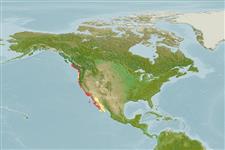>
Scombriformes (Mackerels) >
Stromateidae (Butterfishes)
Etymology: Peprilus: Greek, peprilos, paprax, certain fish from Tracia.
More on author: Ayres.
Environment: milieu / climate zone / depth range / distribution range
Ecologia
marino benthopelagico; distribuzione batimetrica 9 - 91 m (Ref. 2850). Subtropical; 52°N - 23°N, 129°W - 109°W
Northeast Pacific: Queen Charlotte Sound in British Columbia, Canada to southern Baja California Sur and the Gulf of California. Occurrence in Nicaragua needs verification.
Size / Peso / Age
Maturity: Lm ? range ? - ? cm
Max length : 28.0 cm SL maschio/sesso non determinato; (Ref. 9346)
Spine dorsali (totale): 3; Raggi dorsali molli (totale): 45-47; Spine anali 3; Raggi anali molli: 39 - 44; Vertebre: 29. Brilliantly iridescent, green or blue above, silvery below; dusky on fins (Ref. 6885).
Commonly found on sand bottom of exposed coasts. Usually occurs in shallow water near shore and often forms small, but fairly dense, schools (Ref. 4563).
Life cycle and mating behavior
Maturità | Riproduzione | Deposizione | Uova | Fecundity | Larve
Eschmeyer, W.N., E.S. Herald and H. Hammann, 1983. A field guide to Pacific coast fishes of North America. Boston (MA, USA): Houghton Mifflin Company. xii+336 p. (Ref. 2850)
IUCN Red List Status (Ref. 130435)
Threat to humans
Harmless
Human uses
Pesca: commerciale; Pesce da pesca sportiva: si
Informazioni ulteriori
BibliografiaAcquacolturaProfilo di acquacolturaVarietàGeneticaElectrophoresesEreditarietàMalattieElaborazioneNutrientsMass conversion
CollaboratoriImmaginiStamps, Coins Misc.SuoniCiguateraVelocitàModalità di nuotoArea branchialeOtolithsCervelliVista
Strumenti
Special reports
Download XML
Fonti Internet
Estimates based on models
Preferred temperature (Ref.
123201): 8.3 - 21, mean 10.1 °C (based on 54 cells).
Phylogenetic diversity index (Ref.
82804): PD
50 = 0.5020 [Uniqueness, from 0.5 = low to 2.0 = high].
Bayesian length-weight: a=0.01259 (0.00663 - 0.02390), b=3.11 (2.95 - 3.27), in cm total length, based on LWR estimates for this species & Genus-body shape (Ref.
93245).
Trophic level (Ref.
69278): 4.0 ±0.2 se; based on size and trophs of closest relatives
Resilienza (Ref.
120179): Alto, tempo minimo di raddoppiamento della popolazione meno di 15 mesi (Assuming tm=1).
Fishing Vulnerability (Ref.
59153): Low vulnerability (24 of 100).
Climate Vulnerability (Ref.
125649): Moderate to high vulnerability (50 of 100).
Nutrients (Ref.
124155): Calcium = 74.1 [35.3, 186.2] mg/100g; Iron = 0.895 [0.407, 1.915] mg/100g; Protein = 17.7 [15.9, 19.4] %; Omega3 = 0.329 [0.174, 0.615] g/100g; Selenium = 32.1 [14.4, 75.4] μg/100g; VitaminA = 11.2 [2.6, 44.7] μg/100g; Zinc = 0.669 [0.409, 1.104] mg/100g (wet weight);
